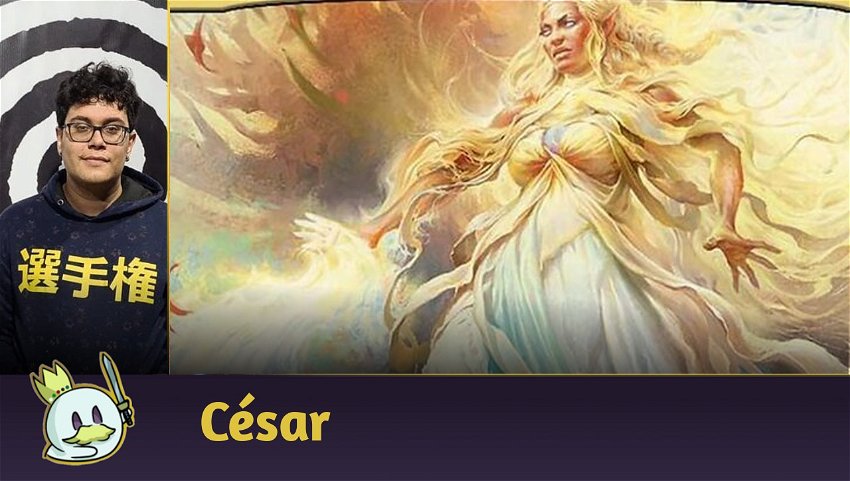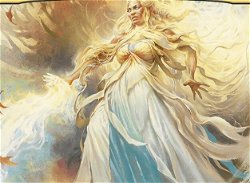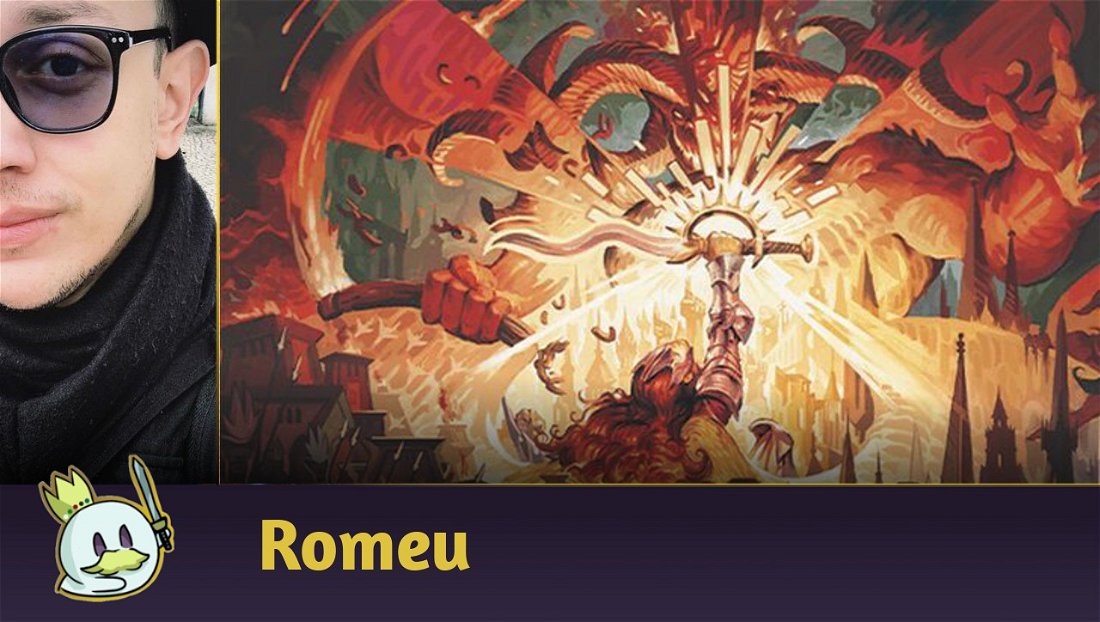Introduction
Commander and Mechanic
Galadriel, Light of Valinor is a diverse commander that can be built in several different ways, including, of course, blink. We chose the classic Elfball strategy, trying to trigger her Alliance every turn as much as we can to extract value of the mana we create, grow creatures and draw cards.

The 


Ad
Galadriel, Light of Valinor List and Deck Strategy
This deck usually wins through combat damage, but there are some classic Elfball combos as backup to create infinite mana and draw our entire deck looking for our win condition. While this doesn't happen, this deck behaves as an Elf typal deck that tries to win by attacking several times.
Accelerators and Mana Dorks

Considering we use countless mana dorks, we only have two mana rocks: Sol Ring and Arcane Signet.
As spells, we have Farseek, Nature's Lore, Three Visits, Cultivate and Kodama's Reach.
As support in general, we have Elven Chorus, which transforms all our creatures into mana dorks and makes it possible for us to cast creatures from the top of our deck.

We have more than enough mana dorks. We use some that are more uncommon in Elf decks, such as Bloom Tender and Incubation Druid, which, with a +1/+1 counter, can create 3 mana - and this is possible as soon as it enters the battlefield thanks to Galadriel's Alliance. Elvish Mystic, Llanowar Elves, Fyndhorn Elves, Priest of Titania, Circle of Dreams Druid, Elvish Archdruid and Marwyn, the Nurturer couldn't be excluded from this deck, considering they are the cards that create the most mana and can possibly be combo pieces.
Elvish Harbinger, besides being a mana dork, tutors some Elf that is relevant for your situation, and can draw directly alongside Galadriel, thanks to Alliance. Wood Elves is also useful to look for Shock Lands or Spara's Headquarters.

Win Conditions

As mentioned, the Elves that create a lot of mana can act as combo pieces with Staff of Domination, to create infinite mana and draw all the cards in this deck. Considering we create at least 5 mana with a creature, we use 3 mana to untap it and 1 mana to untap this staff. You only need to repeat this process until you have as much mana as you want.
It is possible to go for this same strategy with Concordant Crossroads and Emiel the Blessed, if we have at least one creature that creates 4 mana and if we activate Emiel's ability for 3. Emiel can blink Galadriel, reset her Alliance count, and consequently draw our entire deck. Considering we can access all this mana, we can use these 4 options without Elves: Finale of Devastation, Overwhelming Stampede, Craterhoof Behemoth or Moonshaker Cavalry.
Ad

Still with Emiel, it is possible to create infinite Elves with Imperious Perfect, for instance. To win with Elves, we have Haldir, Lórien Lieutenant, Elvish Warmaster, Galadhrim Brigade and Ezuri, Renegade Leader. They are also useful to use our infinite mana and grow the Elves that can attack infinitely, and like so end the game.

Elves and Other Typal Interactions

We have a wide array of Elves to help us grow our creatures or help us in some other way. Roaming Throne naming Elves was a mandatory inclusion, considering it triggers 2 of Galadriel's Alliance abilities instead of one, draws more cards with Beast Whisperer or Elrond, Master of Healing, which can add +1/+1 counters to our cards through Galadriel's Alliance. Drawing cards with Elrond also triggers an additional time thanks to Roaming Throne.

Besides the Lords we already mentioned, we also use Arwen, Weaver of Hope, Imperious Perfect and Leaf-Crowned Visionary, which draw us even more cards. Speaking of drawing cards, Blue helps us with Kindred Discovery, which will give us gas during the game, and Rhystic Study to draw cards or tax opponents and delay their game plan a bit. As for White, it helps us with Aura Shards, which removes problematic cards.

Elven Ambush, besides creating countless Elves, triggers Galadriel's all 3 Alliance options. Arboreal Alliance can increase our number of Elves even more with Populate, or create another Ent, if you chose to create one. Finally, Wolverine Riders is useful to increase even more the number of Elves on the board and also guarantees you more resilience through its life gain.

Answers and Removals

The difference between this deck to a Mono Green Elfball is precisely our number of answers and interaction with the board, considering we can answer spells that destroy everything or that harm our board instead of simply taking a global removal.
The counters we use are the ones that cost very little mana and are very efficient - An Offer You Can't Refuse, Swan Song, Counterspell and Dovin's Veto. Endless Detour catches opponents off guard, both when they cast a spell and when they Reanimate something that is possibly problematic.
Ad

As target removals, we use Path to Exile and Swords to Plowshares to remove creatures, and Beast Within and Generous Gift to remove any type of permanent. Austere Command and Supreme Verdict are global removals that can't be missing from this deck, both to deal with creatures and with other types of permanents that need to be removed in general, and not just occasionally. But, if we're really in a tight spot, that's when Farewell comes in.
Raise the Palisade has this same goal, but it can move blockers out of the way to prepare a relevant attack. Cyclonic Rift also has this goal, and is also a card that can turn the tables for you and become problematic for your opponents.

Besides Raise the Palisade, we have other answers that interact with Elves, such as Galadhrim Ambush to protect us from aggressive decks, creating several Elf tokens, and also Windswift Slice a target removal that also creates Elf tokens. Reclamation Sage is another elven removal in our list.

Besides Galadhrim Ambush and Cyclonic Rift, we have several other defensive spells to preserve our board and/or permanents - Teferi's Protection, Heroic Intervention, Flawless Maneuver, Clever Concealment and Galadriel's Dismissal. I'll highlight Galadriel's Dismissal, considering it can work both defensively (to save our creatures), and aggressively (to phase out all creatures on the board and leave an opponent without any blocker through its Kicker cost).

Galadriel, Light of Valinor Budget List
This is a budget list that is significantly more accessible, but it has some of the original combos, such as Emiel and Staff of Domination, using Thousand-Year Elixir instead. In this version, we use Galadriel's Scry ability in her Alliance a bit more, using cards like Galadriel of Lothlorien, Lost Isle Calling and Elvish Mariner, for instance.
We also work with +1/+1 counters to buff Elves with Hardened Scales, and we have some interactions that work with this, such as Master Biomancer and Rishkar, Peema Renegade. We tried to keep the Elfball essence as much as we could, taking advantage of other existing mechanics to improve this deck's performance during the game.
Final Words
Galadriel was a commander that really stood out to me, and made me really want to test out this deck IRL, considering one of the first typal decks I had was an Elf deck with Ezuri, Renegade Leader, and the deck presented in this article makes me a bit nostalgic. I'm delighted to see how these decks' builds also changed throughout the years, and can fit, mechanically, other color combinations, which give us more recursion and answers to make this strategy even more stable.
Did you like this deck? Do you prefer Galadriel Simic? Or the good old Mono Green Elfball? Share your thoughts in the comment section below!
Ad









— Comments0
Be the first to comment